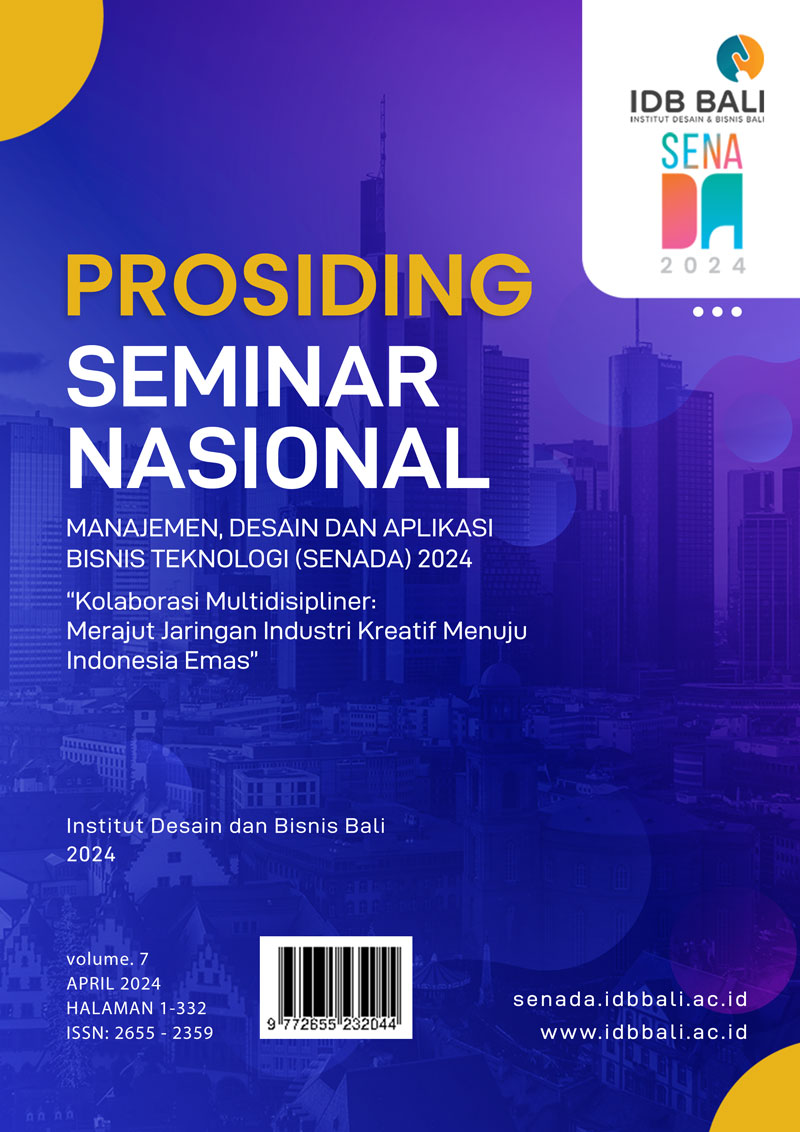PERBANDINGAN EKSPLORASI MOTIF FILAMEN PLA DENGAN TEKNIK 3D PRINTER DAN 3D PEN
Keywords:
Exploration, PLA Filament Motif, 3D Printer, 3D Pen, CreativityAbstract
PLA filament is a raw material for 3D printing technology which has the potential to be developed into design products. In making design products, a planer is needed that is formed from exploring a series of PLA filament motifs. The way to make PLA filament motifs is to use a 3D printer and 3D pen technique. These two techniques are applications of 3D printing technology which both display creativity but with different characters. 3D printers have a structured work system with the help of digital modeling tools, while 3D pens have a work system that relies entirely on manual hand capabilities. This research aims to compare the characteristics of the exploration results of PLA filament motifs using 3D printing technology as a basis for making product designs. Researchers used qualitative comparative methods to analyze the results of exploration and comparison of processed PLA filament motifs. Exploring PLA filament motifs using a 3D printer technique will produce structured filament motif characters, while the 3D pen technique will produce abstract motifs. From the comparison between these two PLA filament motif exploration results, it can be seen that each exploration technique has a different creative approach.
Filamen PLA merupakan bahan baku teknologi 3D printing yang memiliki potensi untuk dikembangkan menjadi produk desain. Dalam pembuatan produk desain tersebut diperlukan suatu bidang yang dibentuk dari eksplorasi rangkaian motif filamen PLA. Adapun cara untuk membuat motif filamen PLA adalah menggunakan teknik 3D printer dan 3D pen. Kedua teknik ini merupakan aplikasi dari teknologi 3D printing yang sama-sama menampilkan kreativitas namun dengan karakter berbeda. 3D printer memiliki sistem kerja terstruktur dengan bantuan alat pemodelan digital, sedangkan 3D pen memiliki sistem kerja yang sepenuhnya mengandalkan kemampuan manual tangan. Penelitian ini bertujuan untuk melihat perbandingan karakteristik hasil eksplorasi motif filamen PLA dengan menggunakan teknologi 3D printing sebagai dasar pembuatan produk desain. Peneliti menggunakan metode kualitatif komparatif untuk menganalisa hasil eksplorasi dan komparasi terhadap hasil olahan motif filamen PLA. Eksplorasi motif filamen PLA menggunakan teknik 3D printer akan menghasilkan karakter motif filamen yang terstruktur, sedangkan teknik 3D pen akan menghasilkan motif yang bersifat abstrak. Dari perbandingan antara kedua hasil eksplorasi motif filamen PLA ini, dapat dilihat bahwa setiap teknik eksplorasi memiliki pendekatan kreativitas yang berbeda.
Downloads
References
[2] N. Shahrubudin, L. T. Chuan and R. Ramlan, "An Overview on 3D Printing Technology: Technological, Materials, and Applications," in 2nd International Conference on Sustainable Materials Processing and Manufacturing, Sun City, 2019.
[3] H. Takahashi and J. Kim, "3D Pen + 3D Printer: Exploring the Role of Humans and Fabrication Machines in Creative Making," in CHI '19: Proceedings of the 2019 CHI Conference on Human Factors in Computing Systems, Glasgow, 2019.
[4] S. Manaher, "Handiwork vs Handwork: When To Use Each One In Writing," The Content Authority, 2023. [Online]. Available: https://thecontentauthority.com/blog/handiwork-vs-handwork. [Accessed 13 January 2024].
[5] D. Oktavian, M. Mahardika and B. Arifvianto, "Ekstrusi dan Karakteristik Filamen Komposit Polylactid Acid (PLA) / Carbon Nano Tube (CNT)," Jurnal Material dan Teknologi Proses, vol. 2, no. 2, pp. 12-16, 2021.
[6] S. S. Hastanti, "Pembelajaran Berkarakteristik Pembelajaran Inovatif Abad 21 Pada Materi Limit Dengan Model Pembelajaran Discovery Learning Di SMK N 1 Adiwerna Kabupaten Tegal," Cakrawala: Jurnal Penelitian, pp. 162-173, 2022.
[7] K. N. Amany, A. Rusmana and R. K. Anwar, "Kegiatan Eksplorasi Dalam Proses Perilaku Pencarian Informasi Seniman Mural Di Institut Kesenian Jakarta," Jurnal Ilmu Perpustakaan dan Informasi, vol. 2, no. 1, pp. 80-87, 2017.
[8] Mulyadi, Buku Ajar CAD/CAM, Sidoarjo: UMSIDA Press, 2018.
[9] F. V. I. R. Muliarso and A. Rizki, "Implementasi CAD (Computer Aided Design) dalam Proses Desain Produk," Jurnal Optimasi Sistem Industri, 2017.
[10] O. P. S. Ardianto, M. Wardhana, T. A. Kristianto, A. A. Rucitra and C. A. Budianto, "Eksplorasi Desain dan Teknik Fabrikasi Digital untuk Elemen Desain Interior Berbasis Teknologi Manufaktur Aditif," Jurnal Desain Interior, vol. 7, no. 2, pp. 73-84, 2022.
[11] D. P. Kosasih, H. D. Nugraha and W. A. Saefullah, "Perancangan Mesin 3D Printing Model Cartesian," Jurnal Teknik Mesin ITI, vol. 5, no. 1, pp. 29-35, 2021.
[12] K. S. Putra and U. R. Sari, "Pemanfaatan Teknologi 3D Printing Dalam Proses Desain Produk Gaya Hidup," in Seminar Nasional Sistem Informasi dan Teknologi Informasi 2018 (SENSITEK 2018), Pontianak, 2018.
[13] J. Chen, S. Xiang, Y. Yuan and Y. Zeng, "The Exploration and Practice of 3D Printing Pen in Primary School Education," in Proceedings of the 2021 International Conference on Diversified Education and Social Development (DESD 2021), Guiyang, 2021.
[14] C. Chen, "Embellished Modularity," in International Textile and Apparel Association Annual Conference Proceedings, Denver, 2022.
[15] P. Sisdianto, "Pemetaan Potensi Manekung Ajar Pikukuh Sunda Bagi Ideasi Proses Kreasi Melalui Pendekatan Etnografi Terhadap Bumi Dega Subda Academy Bandung," Institut Teknologi Bandung, Bandung, 2020.






